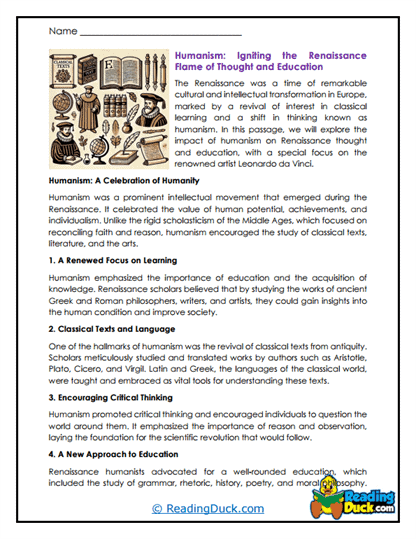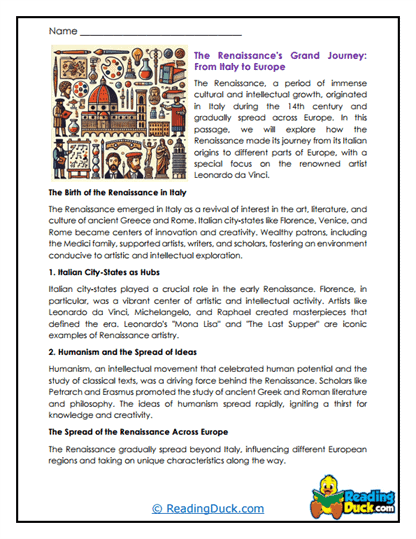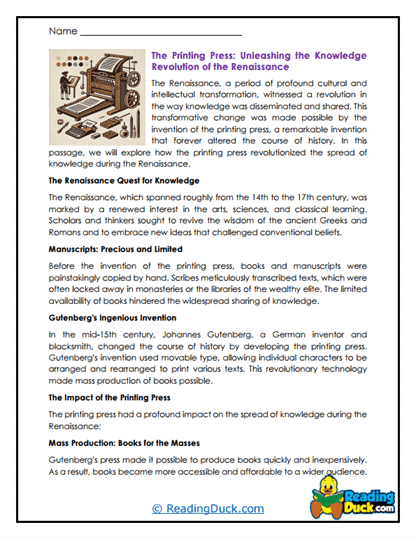The Renaissance Worksheets
About Our Renaissance Worksheets
The Renaissance was a period of immense cultural, artistic, and intellectual growth in Europe, spanning roughly from the 14th to the 17th century. It marked a pivotal shift from the medieval period to the modern age, fostering developments in art, science, literature, and philosophy. Our collection of Renaissance worksheets provides students with an in-depth exploration of this transformative era, helping them connect with the ideas, people, and events that shaped the Renaissance.
Each topic in this collection is covered through several worksheet sets, each designed to engage students in various aspects of the Renaissance. The worksheets include:
- Multiple Choice Questions: These questions assess students’ understanding of key Renaissance figures, events, and ideas, helping reinforce their grasp of the material.
- Short Answer Questions: These prompts encourage students to delve deeper into specific topics, such as the impact of the printing press, the role of patrons in the arts, or the scientific breakthroughs of the period.
- Open-Ended Questions: These questions invite students to express their thoughts and opinions on the Renaissance, fostering critical thinking and personal connection to the material.
Each worksheet is accompanied by an answer key, ensuring that students and educators can easily verify the accuracy of their responses. All worksheets are available in PDF format, making them accessible for electronic viewing, downloading, and printing.
The Renaissance: A Rebirth of Culture and Thought
The Renaissance, often referred to as the "rebirth" of Europe, was a period characterized by a renewed interest in the classical knowledge of Greece and Rome. Teachers might introduce the topic to their students by highlighting the following key aspects:
1. The Origins of the Renaissance:
- Cultural Awakening in Italy: The Renaissance began in Italy, particularly in cities like Florence, Venice, and Rome. The wealthy merchant class, along with powerful families like the Medicis, played a crucial role in funding artists, architects, and scholars, which allowed these cities to flourish as centers of art and learning.
- Rediscovery of Classical Knowledge: The fall of Constantinople in 1453 and the subsequent migration of Greek scholars to the West brought with them classical texts that had been lost to Europe for centuries. This rekindled interest in ancient philosophies, sciences, and arts that had a profound influence on Renaissance thought.
- Humanism: At the heart of the Renaissance was the intellectual movement known as Humanism, which emphasized the study of classical texts, the value of the individual, and the potential for human achievement. Humanists like Petrarch and Erasmus advocated for education reform and the study of the humanities.
2. Key Figures and Achievements of the Renaissance:
- Leonardo da Vinci: Often called the quintessential "Renaissance Man," Leonardo was a painter, scientist, inventor, and writer. His works, such as "The Last Supper" and "Mona Lisa," epitomize the Renaissance ideals of beauty, balance, and realism.
- Michelangelo: Another towering figure of the Renaissance, Michelangelo was a sculptor, painter, and architect. His masterpieces include the statue of David, the ceiling of the Sistine Chapel, and the design of St. Peter's Basilica in Vatican City.
- Galileo Galilei: Known as the father of modern observational astronomy, Galileo made significant contributions to science during the Renaissance. His support for the heliocentric theory and improvements to the telescope challenged the established scientific views of his time.
- The Printing Press: Invented by Johannes Gutenberg, the printing press revolutionized the spread of knowledge. It allowed for the mass production of books, making literature, scientific texts, and ideas more accessible to the public and accelerating the spread of Renaissance ideas across Europe.
3. The Legacy of the Renaissance:
- Artistic Innovation: The Renaissance is renowned for its artistic advancements. Techniques such as linear perspective, chiaroscuro (the treatment of light and shadow), and a focus on human anatomy revolutionized the way art was created and perceived. Artists like Raphael, Titian, and Botticelli pushed the boundaries of what was possible in painting and sculpture.
- Scientific Inquiry: The spirit of curiosity and inquiry that characterized the Renaissance laid the groundwork for the Scientific Revolution. The period saw the beginnings of modern science, with thinkers like Copernicus and Kepler challenging traditional views of the cosmos.
- Philosophical and Political Thought: The Renaissance also brought about new ways of thinking about society, politics, and the individual’s role within them. Machiavelli’s "The Prince" offered a new perspective on power and statecraft, while Thomas More’s "Utopia" envisioned an ideal society.
- Global Exploration: The Renaissance coincided with the Age of Exploration, as European powers began to explore and colonize other parts of the world. This era of discovery expanded Europe’s horizons, leading to significant cultural exchanges, as well as the darker aspects of colonization and exploitation.
By exploring these aspects, students can develop a comprehensive understanding of how the Renaissance shaped the modern world.
The Renaissance's Impact on World History
1. The Cultural Reawakening:
- Revival of Classical Antiquity: The Renaissance marked a return to the ideals of classical antiquity, which influenced everything from architecture to literature. The renewed interest in Greek and Roman culture helped shape modern Western civilization.
- Humanism and Education: The emphasis on humanism during the Renaissance led to a renewed focus on education. The study of classical languages, literature, and philosophy became central to the curriculum of European universities, influencing educational practices for centuries to come.
- Artistic Mastery: The techniques and principles developed during the Renaissance set new standards for artistic excellence. The works of Renaissance artists continue to be studied, admired, and emulated to this day.
2. The Scientific Revolution:
- Foundation for Modern Science: The Renaissance’s emphasis on observation, experimentation, and questioning of traditional knowledge laid the groundwork for the Scientific Revolution. Figures like Copernicus, Galileo, and Newton built upon Renaissance ideas to develop the modern scientific method.
- Challenges to Authority: The Renaissance encouraged a questioning of authority, whether it was the Church, traditional science, or political power. This spirit of inquiry and skepticism was crucial to the development of modern science and philosophy.
3. Political and Social Change:
- Shift in Power Dynamics: The Renaissance saw the rise of powerful city-states and the decline of feudalism. This shift in power dynamics paved the way for the modern nation-state and influenced the development of modern political systems.
- Global Expansion: The Renaissance era’s advancements in navigation and cartography facilitated European exploration and colonization. While this led to cultural exchanges and the spread of Renaissance ideas globally, it also had significant consequences for indigenous populations and contributed to the rise of the Atlantic slave trade.
Integrating Renaissance Worksheets in Education
Teachers and parents can use these Renaissance worksheets in various creative and effective ways:
- Cross-Curricular Projects:
- Art and History Integration: Encourage students to recreate a famous Renaissance artwork or architectural design and research the historical context behind it. This can help them connect art and history in a meaningful way.
- Literature and Philosophy: Pair the study of Renaissance literature, such as works by Dante, Shakespeare, or Machiavelli, with the historical and philosophical context provided by the worksheets. This can deepen students’ understanding of the period’s intellectual currents.
- Interactive Learning:
- Debates and Role-Playing: Organize debates or role-playing activities where students represent different Renaissance figures, such as artists, scientists, or political leaders. This helps students engage with the material actively and understand different perspectives.
- Timeline Creation: Have students create timelines that chart the major events, discoveries, and cultural shifts of the Renaissance. This visual exercise helps students see the broader picture and understand how different developments were interconnected.
- Critical Thinking Exercises:
- Comparative Analysis: Ask students to compare the Renaissance with other periods of cultural and intellectual revival, such as the Enlightenment or the Industrial Revolution. This fosters critical thinking and helps students make connections across different historical periods.
- Ethical Discussions: Use the Renaissance as a starting point for discussions on ethics, such as the role of patronage in the arts, the impact of exploration on indigenous peoples, or the ethical implications of scientific discovery.
- Home Learning:
- Family Involvement: Encourage students to share what they’ve learned about the Renaissance with their families through discussions, presentations, or creative projects. This reinforces learning and fosters a supportive learning environment at home.
- Self-Paced Learning: Provide the worksheets as part of a self-paced learning module that students can work on independently. This approach is particularly effective in a homeschool setting or as supplementary material for classroom learning.
By incorporating these worksheets into lessons, teachers and parents can help students gain a deep and nuanced understanding of the Renaissance. This collection not only covers the historical facts but also encourages students to think critically, make connections, and appreciate the lasting legacy of this remarkable period in world history.









